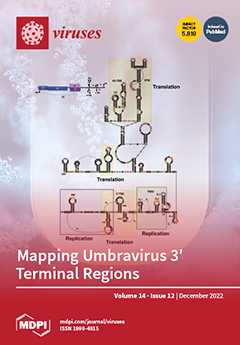Bacterial viruses known as bacteriophages have been demonstrated to be effective in killing foodborne pathogens such as
Shigella flexneri. Adsorption is the first step in the phage–host interaction. In the present work, 10
Shigella phages were used to characterize the adsorption process
[...] Read more.
Bacterial viruses known as bacteriophages have been demonstrated to be effective in killing foodborne pathogens such as
Shigella flexneri. Adsorption is the first step in the phage–host interaction. In the present work, 10
Shigella phages were used to characterize the adsorption process on
Shigella flexneri ATCC12022 in several physicochemical conditions related to food and in a food matrix. One-step growth curves were drawn for all the
Shigella-phages evaluated. Furthermore, the adsorption rate for each of the 10 phages was determined. In addition, the influence of temperature, Na
+, Mg
2+, pH, sucrose and glycerol on phage adsorption was investigated. Two phages (Shi22 and Shi30) showed higher burst sizes values (67 and 64 PFU cell
−1, respectively) and burst times of 25 min to 30 min, while the other eight phages exhibited burst sizes ranging from 14 to 17 PFU cell
−1 with slower burst times. Furthermore, most phages achieved a high adsorption rate, and the adsorption constants (
k) ranged from ~10
−9 to 10
−10 mL min
−1. Regarding the influence of temperature, cations and pH, a high or moderate percentage of adsorption was observed for most of the phages evaluated. The adsorption decreased at increasing concentrations of Na
+, sucrose and glycerol, although at different levels, since adsorption was more affected by sucrose than by glycerol and Na
+ for most phages. The adsorption obtained in Triptein soy broth (TSB) for most of the phages/strain systems evaluated was moderate or high, as well as those observed in a food matrix. Thus, our phages could potentially be used to improve food safety under a wide range of environmental conditions against foodborne pathogens.
Full article






